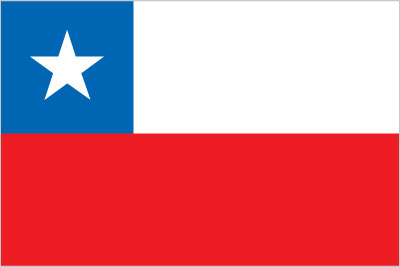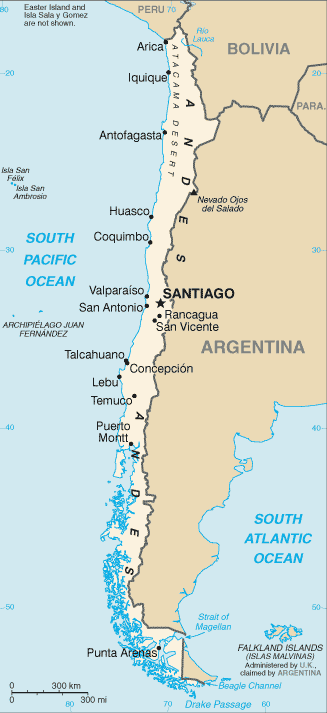Exporting to Chile


Chile Country Profile
Official Name (Local Language) República de Chile
Capital Santiago
Population 17,650,114
Currency Chilean Peso
GDP $234.9 billion
Languages Spanish
Phone Dial In 56
Chile Imports Profile
Imports ($m USD) 65,062
Number of Imports Products 4,318
Number of Imports Partners 183

Chile Economic Statistics
Government Website | https://www.gob.cl/ |
| Sovereign Ratings | https://countryeconomy.com/ratings/chile |
| Central Bank | Banco Central de Chile |
| Currency USD Exchange Rate | 673.2 |
| Unemployment Rate | 7% |
| Population below poverty line | 14.4% |
| Inflation Rate | 4.1% |
| Prime Lending Rate | 3.35% |
| GDP | $234.9 billion |
| GDP Pro Capita (PPP) | $44,000 |
| Currency Name | Chilean Peso |
| Currency Code | CLP |
| World Bank Classification | High Income |
| Competitive Industrial Performance | 33/138 |
| Corruption Perceptions Index | 26/180 |
| Ease of Doing Business | 56/190 |
| Enabling Trade Index | 21/136 |
Access trade, receivables and supply chain finance
We assist companies to access trade and receivables finance through our relationships with 270+ banks, funds and alternative finance houses.
Get StartedExporting to Chile
As a net exporter, Chile’s economy is highly dependent on trade, which makes up over three quarters of its GDP. Chile’s biggest imports are oil, cars, and computers. The country gets almost all its oil from the US; other import sources are China, Brazil, and Argentina. Chile is an important maritime trading nation, spanning almost the entirety of the Western Latin American coast, and is home to 2 of the 10 busiest ports in Latin America. Almost all of its trade happens via sea, and Chile’s almost 60 ports ensure trade is efficient and delays are uncommon.
The Punta Arenas strait at the southernmost tip of the country has been seeing a significant increase in traffic as ships are diverted away from the Suez Canal due to Houthi violence and from Panama due to droughts. This has led to increased investment from the government to modernise the existing ports and build new ones, as well as foreign investment from the US and China to capitalise on this shift and on the rise in green energy passing through the region. In the future, Chile could become an even more crucial trading hub as surrounding waters become more accessible due to melting ice caps and trade becomes permanently diverted to Punta Arenas.
Chile is one of the most economically stable and successful countries in the region, with almost nonexistent corruption and a well-functioning government. Because there has been no significant economic turmoil recently, Chile is open to trade, with low tariffs and no significant barriers to imports. Foreign companies are afforded almost exactly the same rights as domestic ones and except for a very limited number of products, import restrictions are essentially non-existent.
Exporting to Chile: What is trade finance?
The nation’s major export items would include refine copper ($19 billion), copper ore ($18 billion), and sulfate chemical wood pulp ($2.9 billion) and fish fillets ($2 billion). Apart from these commodities, Chile also exports fruits, paper and pulp, wine and chemicals to other countries. Some of Chile’s export partners would include China ($19 billion), the United States ($10 billion), Japan ($8 billion) and Brazil ($4 billion). The export industry of Chile comprises 40% of the nation’s GDP and more of 75% of Chile’s shipments are export commodities.
Chart Showing GDP Growth Compared to rest of world
GDP Composition for Chile
Agriculture
4%
Grapes, apples, pears, onions, wheat, corn, oats, peaches, garlic, asparagus, beans; beef, poultry, wool; fish; timber
Industry
32.4%
Copper, lithium, other minerals, foodstuffs, fish processing, iron and steel, wood and wood products, transport equipment, cement, textiles
Services
63.6%
Map
Top 5 Imports Partners
| Country | Trade | % Partner Share |
| China | 15,505 | 23.83 |
| United States | 11,742 | 18.05 |
| Brazil | 5,607 | 8.62 |
| Argentina | 2,925 | 4.50 |
| Germany | 2,650 | 4.07 |
Top 5 Imports Products
| Export Product | Number |
| Petroleum oils, etc, (excl. crude); preparation | 6.5% |
| Petroleum oils and oils obtained from bituminou | 5.9% |
| Transmission apparatus, for radioteleph incorpo | 4.8% |
| Automobiles with reciprocating piston engine di | 4.0% |
| Diesel powered trucks with a GVW not exceeding | 3.6% |
Local Partners
- All Topics
- Chilean Trade Resources
- Export Finance and ECA Topics
- Local Conferences



















